Geothermal Potential of Hot Dry Rock in South-East Baltic Basin Countries—A Review
Abstract
:1. Introduction
2. Current State of Energy Production and Consumption in the Baltic States
3. Development of Enhanced Geothermal Systems in the World
4. Technical Aspects of Geothermal Collectors in Hot Dry Rocks
5. Potential of Hot Dry Rock in Countries of the South-East Baltic Basin
5.1. Lithuania
5.2. Latvia
5.3. Estonia
5.4. Poland
6. Discussion
7. Conclusions
Author Contributions
Funding
Data Availability Statement
Conflicts of Interest
References
- Olasolo, P.; Juares, M.C.; Morales, M.P.; D’Amico, S.; Liarte, I.A. Enhanced geothermal systems (EGS): A review. Renew. Sustain. Energy Rev. 2016, 56, 133–144. [Google Scholar] [CrossRef]
- Lu, S.M. A global review of enhanced geothermal system (EGS). Renew. Sustain. Energy Rev. 2018, 81, 2902–2921. [Google Scholar] [CrossRef]
- Moska, R.; Labus, K.; Kasza, P. Hydraulic Fracturing in Enhanced Geothermal Systems—Field, Tectonic and Rock Mechanics Conditions—A Review. Energies 2021, 14, 5725. [Google Scholar] [CrossRef]
- Tester, J.; Anderson, B.; Batchelor, A.; Blackwell, D.; DiPippo, R.; Drake, M.; Garnish, J.; Livesay, B.; Moore, M.; Nichols, K. The Future of Geothermal Energy—Impact of Enhanced Geothermal Systems (EGS) on the United States in the 21st Century; Massachusetts Institute of Technology: Cambridge, MA, USA, 2006. [Google Scholar]
- Krishans, Z.; Mutule, A.; Oleinikova, I.; Kutjuns, A. Application of Risk Assessment Method for Baltic States Power System Development Optimization. In Proceedings of the International Conference on Probabilistic Methods Applied to Power Systems, Stockholm, Sweden, 11–15 June 2006. [Google Scholar] [CrossRef]
- ec.europa.eu/Eurostat. Available online: https://ec.europa.eu/eurostat/cache/infographs/energy_dashboard/endash.html?geo=LV&year=2020&language=EN&detail=1&nrg_bal=&unit=MTOE&chart=chart_seven,chart_six,chart_two,chart_five,chart_one,chart_four&modal=0 (accessed on 21 November 2022).
- Batchelor, A.S. Reservoir behavior in a stimulated Hot Dry Rock system. In Proceedings of the 11th Annual Workshop on Geothermal Reservoir Engineering, Stanford, CA, USA, 21–23 January 1986. [Google Scholar]
- Batchelor, A.S. Development of Hot-Dry-Rock geothermal systems in the UK. Thermal Power IEE Proc. 1987, 134A, 371–380. [Google Scholar] [CrossRef]
- Richards, H.; Parker, R.; Green, A.; Jones, R.; Nicholls, J.; Nicol, D.; Randall, M.; Richards, S.; Stewart, R.; Willis-Richards, J. The performance and characteristics of the experimental hot dry rock geothermal reservoir at Rosemanowes, Cornwall (1985–1988). Geothermics 1994, 23, 73–109. [Google Scholar] [CrossRef]
- Wyborn, D.; da Graaf, L.; Davidson, S.; Hann, S. Development of Australia’s first hot fractured rock (HFR) underground heat exchanger, Cooper Basin, South Australia. In Proceedings of the World Geothermal Congress, Antalya, Turkey, 24–29 April 2005. [Google Scholar]
- Holl, H.G. What Did We Learn about EGS in the Cooper Basin? Geodynamics Limited Technical Report; Geodynamics Limited: Milton, Australia, 2015. [Google Scholar]
- Holl, H.G.; Barton, C. Habanero Field—Structure and state of stress. In Proceedings of the World Geothermal Congress, Melbourne, Australia, 19–25 April 2015. [Google Scholar]
- Orzol, J.; Jung, R.; Jatho, R.; Tischner, T.; Kehrer, P. The GeneSys-Project: Extraction of geothermal heat from tight sediments. In Proceedings of the World Geothermal Congress, Antalya, Turkey, 24–29 April 2005. [Google Scholar]
- Blöcher, G.; Reinsch, T.; Henninges, J.; Milsch, H.; Regensprug, S.; Kummerow, J.; Francke, H.; Kranz, S.; Saadat, A.; Zimmermann, G. Hydraulic history and current state of the deep geothermal reservoir Groß Schönebeck. Geothermics 2015, 63, 27–43. [Google Scholar] [CrossRef]
- Wakahama, H.; Mito, S.; Ohsumi, T.; Ueda, A.; Yajima, T.; Satoh, H.; Sugyima, K.; Ozawa, A.; Todaka, N.; Sato, T.; et al. A concept of CO2 Georeactor sequestration at the Ogachi HDR site. Energy Procedia 2009, 1, 3683–3689. [Google Scholar] [CrossRef]
- Tischner, T.; Evers, H.; Hauswirth, H.; Jatho, R.; Kosinowski, M.; Sulzbacher, H. New concepts for extracting geothermal energy from one well: The GeneSys project. In Proceedings of the World Geothermal Congress, Bali, Indonesia, 25–29 April 2010. [Google Scholar]
- Lei, Z.; Zhang, Y.; Yu, Z.; Hu, Z.; Li, L.; Zhang, S.; Fu, L.; Zhou, L.; Xie, Y. Exploratory research into the enhanced geothermal system power generation project: The Qiabuqia geothermal field, Northwest China. Renew. Energy 2019, 139, 52–70. [Google Scholar] [CrossRef]
- Lei, Z.; Zhang, Y.; Zhang, S.; Fu, L.; Hu, Z.; Yu, Z.; Li, L.; Zhou, J. Electricity generation from a three-horizontal-well enhanced geothermal system in the Qiabuqia geothermal field, China: Slickwater fracturing treatments for different reservoir scenarios. Renew. Energy 2020, 145, 65–83. [Google Scholar] [CrossRef]
- Moore, J.; McLennan, J.; Pankow, K.; Simmons, S.; Podgorney, R.; Wannamaker, P.; Jones, C.; Rickard, W.; Xing, P. The Utah Frontier Observatory for Research in Geothermal Energy (FORGE): A Laboratory for characterizing, creating and sustaining enhanced geothermal systems. In Proceedings of the 45th Workshop on Geothermal Reservoir Engineering, Stanford, CA, USA, 10–12 February 2020. [Google Scholar]
- Vidal, J.; Genter, A. Overview of naturally permeable fractured reservoirs in the central and southern Upper Rhine Graben: Insights from geothermal wells. Geothermics 2018, 74, 57–73. [Google Scholar] [CrossRef]
- Kukkonen, I.T.; Pentti, M. St1 Deep Heat Project: Geothermal energy to the district heating network in Espoo. In Proceedings of the 17th World Conference ACUUS 2020, Helsinki, Finland, 3–4 February 2021; IOP Conference Series: Earth and Environmental Science. IOP Publishing: Bristol, UK, 2021; Volume 703, p. 012035. [Google Scholar] [CrossRef]
- Ladner, F.; Häring, M. Hydraulic characteristics of the Basel-1 enhanced geothermal system. GRC Trans. 2009, 33, 199–204. [Google Scholar]
- Ellsworth, W.L.; Giardini, D.; Townend, J.; Ge, S.; Shimamoto, T. Triggering of the Pohang, Korea, earthquake (Mw 5.5) by enhanced geothermal system stimulation. Seismol. Res. Lett. 2019, 90, 1844–1858. [Google Scholar] [CrossRef]
- Hofmann, H.; Zimmermann, G.; Farkas, M.; Huegenes, E.; Zang, A.; Leonhardt, M.; Kwiatek, G.; Martinez-Garzon, P.; Bonhoff, M.; Min, K.-B. First field application of cyclic soft stimulation at the Pohang Enhanced Geothermal System site in Korea. Geophys. J. Int. 2019, 217, 926–949. [Google Scholar] [CrossRef]
- Park, S.; Kim, K.I.; Xie, L.; Yoo, H.; Min, K.B.; Kim, M.; Yoon, B.; Kim, K.Y.; Zimmermann, G.; Guinot, F. Observations and analyses of the first two hydraulic stimulations in the Pohang geothermal development site, South Korea. Geothermics 2020, 88, 101905. [Google Scholar] [CrossRef]
- Ree, J.H.; Kim, K.H.; Lim, H.; Seo, W.; Kim, S.; An, X.; Kim, Y. Fault reactivation and propagation during the 2017 Pohang earthquake sequence. Geothermics 2021, 92, 102048. [Google Scholar] [CrossRef]
- Schindler, M.; Nami, P.; Schellschmidt, R.; Teza, D.; Tischner, T. Summary of hydraulic stimulation operations in the 5 km deep crystalline HDR/EGS reservoir at Soults-sous-Forets. In Proceedings of the 33th Workshop on Geothermal Reservoir Engineering, Stanford, CA, USA, 28–30 January 2008. [Google Scholar]
- Baujard, C.; Genter, A.; Dalmais, E.; Maurer, V.; Hehn, R.; Rosillette, R.; Vidal, J.; Schmittbuhl, J. Hydrothermal characterization of wells GRT-1 and GRT-2 in Rittershoffen, France: Implications on the understanding of natural flow systems in the Rhine graben. Geothermics 2017, 65, 255–268. [Google Scholar] [CrossRef]
- Huenges, E.; Holl, H.-G.; Bruhn, D.; Brandt, W.; Saadat, A.; Moeck, I.; Zimmermann, G. Current state of the EGS project Groß Schönebeck—Drilling into the deep sedimentary geothermal reservoir. In Proceedings of the European Geothermal Congress 2007, Unterhaching, Germany, 30 May–1 June 2007. [Google Scholar]
- Moeck, I.; Holl, H.G. The stress regime in Rotliegend reservoir of the Northeast German Basin. Int. J. Earth Sci. 2009, 98, 1643–1657. [Google Scholar] [CrossRef]
- Wójcicki, A.; Sowizdżał, A.; Bujakowski, W. Ocena Potencjału Bilansu Cieplnego i Perspektywicznych Struktur Geologicznych dla Potrzeb Zamkniętych Systemów Geotermicznych (Hot Dry Rocks) w Polsce; Ministerstwo Środowiska: Warsaw, Poland, 2013. (In Polish) [Google Scholar]
- Schindler, M.; Baumgärtner, J.; Gandy, T.; Hauffe, P.; Hettkamp, T.; Menzel, H.; Penzkofer, P.; Teza, D.; Tischner, T.; Wahl, G. Successful hydraulic stimulation techniques for electric power production in the Upper Rhine Graben, Central Europe. In Proceedings of the World Geothermal Congress, Bali, Indonesia, 25–29 April 2010. [Google Scholar]
- Leonhardt, M.; Kwiatek, G.; Martinez-Garzon, P.; Bonhoff, M.; Heikkinen, P.; Dresen, G. Seismicity during and after stimulation of a 6.1 km deep enhanced geothermal system in Helsinki, Finland. Solid Earth 2021, 12, 581–594. [Google Scholar] [CrossRef]
- Kasza, P. Hydraulic fracturing in unconventional reservoirs and methods of their analysis. Prace INiG-PIB 2019, 226, 1–147. (In Polish) [Google Scholar]
- Povilas, S.; Rasteniene, V.; Zinevicius, F. Geothermal Potential of Lithuania and Outlook for its Utilization. In Proceedings of the World Geothermal Congress 2000, Kyushu-Tohoku, Japan, 28 May–10 June 2000. [Google Scholar]
- Zinevicius, F.; Sliaupa, S. Lithuania–Geothermal Energy Country Update. In Proceedings of the World Geothermal Congress 2010, Bali, Indonesia, 25–29 April 2010. [Google Scholar]
- Zinevicius, F.; Sliaupa, S.; Mazintas, A.; Dagilis, V. Geothermal Energy Use in Lithuania. In Proceedings of the World Geothermal Congress 2015, Melbourne, Australia, 19–25 April 2015. [Google Scholar]
- Zinevicius, F.; Sliaupa, S.; Mazintas, A.; Dagilis, V. Geothermal Energy Use, Country Update for Lithuania. In Proceedings of the European Geothermal Congress 2016, Strasbourg, France, 19–24 September 2016. [Google Scholar]
- Zinevicius, F.; Sliaupa, S.; Mazintas, A.; Nika, N. Geothermal Energy Update–Lithuania. In Proceedings of the World Geothermal Congress 2021, Reykjavik, Iceland, 24–27 October 2021. [Google Scholar]
- Rasteniene, V.; Puronas, V. Geothermal Atlas of Lithuania. In Proceedings of the World Geothermal Congress 2005, Antalya, Turkey, 24–29 April 2005. [Google Scholar]
- Sliaupa, S.; Motuza, G.; Korabliova, L.; Ciuraite, K.; Puronas, V. Geothermal Potential of Hot Granites of Lithuania. In Proceedings of the World Geothermal Congress 2010, Bali, Indonesia, 25–29 April 2010. [Google Scholar]
- Motuza, G.; Motuza, V.; Salnikova, E.; Kotov, A. Extensive charnockitic-granitic magmatism in the crystalline crust of West Lithuania. Geologija 2008, 61, 1–16. [Google Scholar] [CrossRef]
- Povilanskas, R.; Satkunas, J.; Jurkus, E. Conditions for deep geothermal energy utilisation in southwest Latvia: Nica case study. Baltica 2013, 26, 193–200. [Google Scholar] [CrossRef]
- Borodinecs, A.; Odineca, T.; Zajacs, A.; Migla, L.; Shutenkova, O. Review of the Geothermal Energy Potential in the Europe and Latvia. 2020. Available online: https://ieei.rtu.lv/rtuaer/files/Review%20of%20the%20geothermal%20energy%20potential%20in%20the%20Europe%20and%20Latvia.pdf (accessed on 10 December 2022).
- Dreimanis, A.; Kārklin, O.L. Latvia. In Encyclopedia of European and Asian Regional Geology; Encyclopedia of Earth Science; Springer: Dordrecht, The Netherlands, 1997. [Google Scholar] [CrossRef]
- Soesoo, A.; Nirgi, S.; Plado, J. The evolution of the Estonian Precambrian basement: Geological, geophysical and geochronological constraints. Proc. Karelian Res. Cent. Russ. Acad. Sci. 2020, 10, 18–33. [Google Scholar] [CrossRef]
- Koppelmaa, H.; Klein, V.; Puura, V. Metamorfitsheskije kompleksii kristallitsheskogo fundamenta Estonii. In Metamorfitsheskije kompleksii fundamenta russkoi plitii; Dagelaiskii, V., Bondarenko, L., Eds.; Nauka: Leningrad, Russia, 1978; pp. 43–76. (In Russian) [Google Scholar]
- Puura, V.; Vaher, R.; Klein, V.; Koppelmaa, H.; Niin, M.; Vanamb, V.; Kirs, J. The Crystalline Basement of Estonian Territory; Nauka: Leningrad, Russia, 1983; p. 208. (In Russian) [Google Scholar]
- Nurmi, P.A. Preliminary Evaluation of the Estonian Geoenergy Potential and Overview of Available Technologies, Expert Opinion for Using Those Technologies in the Estonian Geological Conditions, Suggestions for Possible Further Actions and Examples of Case Studies. Technical Report. Tallin. 2021. Available online: https://www.researchgate.net/publication/352197150_Preliminary_evaluation_of_the_Estonian_geoenergy_potential_and_overview_of_available_technologies_expert_opinion_for_using_those_technologies_in_the_Estonian_geological_conditions_suggestions_for_possiblefurtheractionsandexamplesofcasestudies (accessed on 11 October 2022).
- Eklund, O.; Soesoo, A.; Linna, A. The Precambrian Rocks of Southern Finland and Estonia; Institute of Geology at Tallinn University of Technology and University of Turku, Department of Geology: Tallin, Estonia, 2007. [Google Scholar]
- Rämö, O.T.; Huhma, H.; Kirs, J. Radiogenic isotopes of the Estonian and Latvian rapakivi granite suites: New data from the concealed Precambrian of the East European Craton. Precambrian Res. 1996, 79, 209–226. [Google Scholar] [CrossRef]
- Soesoo, A. Geothermal Potential of Estonia; Estonian Geothermal Association, Institute of Geology at TUT: Tallin, Estonia, 2012. [Google Scholar]
- Kukkonen, I.; Jõleleht, A. Weichselian temperatures from geothermal heat flow data. J. Geophys. Res. Atmos. 2003, 108, 2163. [Google Scholar] [CrossRef]
- Jõeleht, A. Estonia. In Atlas of Geothermal Resources in Europe; Hurter, S., Haenel, R., Eds.; Publication EUR 17811; European Commission: Brussels, Belgium, 2002; pp. 28–29. [Google Scholar]
- Jõeleht, A. Geothermal Heat Flow and Radiogenic Heat Production of Estonian Precambrian Basement; Geological Survey of Estonia, Department of Marine Geology and Geophysics: Talinn, Estonia, 1994. [Google Scholar]
- Joeleht, A.; Kukkonen, I.T. Thermal properties of granulite facies rocks in the Precambrian basement of Finland and Estonia. Tectonophysics 1998, 291, 195–203. [Google Scholar] [CrossRef]
- Hurter, S.; Haenel, R. Atlas of Geothermal Resources in Europe; Leibniz Institute for Applied Geosciences, European Communities: Brussels, Belgium, 2002. [Google Scholar]
- Kukkonen, I.T.; Pentti, M.; Heikkinen, P.J. St1 Deep Heat Project: Hydraulic stimulation at 5–6 km depth in crystalline rock. In Proceedings of the LITHOSPHERE Symposium, Virtual, 19–20 January 2021. [Google Scholar]
- Kwiatek, G.; Saarno, T.; Ader, T.; Blueme, F.; Bohnhoff, M.; Chendorian, M.; Dresen, G.; Keikkinen, P.; Kukkonen, I.; Leary, P.; et al. Controlling fluid-induced seismicity during a 6.1-km-deep geothermal stimulation in Finland. Sci. Adv. 2019, 5, 7224. [Google Scholar] [CrossRef]
- Farkas, M.P.; Hofman, H.; Zimmermann, G.; Zang, A.; Bethmann, F.; Cottrell, M.; Josephson, N. Hydromechanical analysis of the second hydraulic stimulation in well PX-1. Geothermics 2021, 89, 101990. [Google Scholar] [CrossRef]
- Szewczyk, J.; Gientka, D. Mapa Gęstości Ziemskiego Strumienia Cieplnego Polski; Polish Geological Institute: Warsaw, Poland, 2009. (In Polish) [Google Scholar]
- Szewczyk, J. Geophysical and hydrogeological aspects of utilization of thermal energy in Poland. Przegl. Geol. 2010, 7, 566–573. (In Polish) [Google Scholar]
- Sowiżdżał, A.; Gładysz, P.; Pająk, L. Sustainable use of petrothermal resources—A review of the geological conditions in Poland. Resources 2021, 10, 8. [Google Scholar] [CrossRef]
- Available online: http://geoportal.pgi.gov.pl/css/zrozum_z/images/podrecznik/gs/Rys_GS_wstep2.jpg (accessed on 30 December 2022).
- Motuza, G.; Sliaupa, S.; Stephenson, R. Genesis of high intensity intracratonic heat flow anomalies: Case study of Western Lithuania. In Proceedings of the EGS-AGU-EUG Joint Assembly, Nice, France, 6–11 April 2003. [Google Scholar]
- Eihmanis, E. Incorporation of Geothermal Heat Sources in Latvian heat Supply Systems. In Proceedings of the World Geothermal Congress 2000, Kyushu-Tohoku, Japan, 28 May–10 June 2000. [Google Scholar]
- Chomać-Pierzecka, E.; Sobczak, A.; Soboń, D. The Potential and Development of the Geothermal Energy Market in Poland and the Baltic States—Selected Aspects. Energies 2022, 15, 4142. [Google Scholar] [CrossRef]
- Joeleht, A.; Kukkonen, I. Physical properties of Vendian to Devonian sedimentary rocks in Estonia. GFF 2002, 124, 65–72. [Google Scholar] [CrossRef]
- Górecki, W. (Ed.) Atlas of Geothermal Resources in the Polish Lowlands; AGH University of Science and Technology: Cracow, Poland, 2006. [Google Scholar]
- Karwasiecka, M. The comparison of geothermal environment in the Upper Silesian Coal Basin and Lublin Coal Basin. Geologia 2008, 34, 335–357. [Google Scholar]
- Miecznik, M.; Sowiżdżał, A.; Tomaszewska, B.; Pająk, L. Modelling geothermal conditions in part of the Szczecin Trough—The Chociwel Area. Geologos 2015, 21, 187–196. [Google Scholar] [CrossRef]
- Buła, Z.; Żaba, J. Pozycja tektoniczna Górnośląskiego Zagłębia Węglowego na tle prekambryjskiego i dolnopaleozoicznego podłoża. In Geologia i Zagadnienia Ochrony Środowiska w Regionie Górnośląskim; Jureczka, J., Buła, Z., Żaba, J., Eds.; Polish Geological Institute, Polish Geological Society: Warsaw, Poland, 2005. (In Polish) [Google Scholar]
- Tuuling, I. The Leba Ridge-Riga-Pskov Fault Zone—A major East European Craton interior dislocation zone and its role in the early Palaeozoic development of the platform cover. Est. J. Earth Sci. 2019, 68, 161–189. [Google Scholar] [CrossRef]
- Brehme, M.; Nowak, K.; Banks, D.; Petrauskas, S.; Valickas, R.; Bauer, K.; Burnside, N.; Boyce, A. A Review of the Hydrochemistry of a Deep Sedimentary Aquifer and Its Consequences for Geothermal Operation: Klaipeda, Lithuania. Geofluids 2019, 2019, 4363592. [Google Scholar] [CrossRef]
- Available online: https://otworywiertnicze.pgi.gov.pl/ (accessed on 30 December 2022).
- Jarosiński, M. Współczesny reżim tektoniczny w Polsce na podstawie analizy testów szczelinowania hydraulicznego ścian otworów wiertniczych. Przegląd Geol. 2005, 53, 863–872. (In Polish) [Google Scholar]
- Jarosiński, M. Recent tectonic stress field investigations in Poland: A state of the art. Geol. Q. 2006, 50, 303–321. [Google Scholar]
- Śmigielski, M.; Koprianiuk, M. Współczesny reżim tektoniczny w Polsce na podstawie analizy testów szczelinowania hydraulicznego ścian otworów wiertniczych w Polsce–dyskusja. Przegląd Geol. 2006, 54, 126–128. (In Polish) [Google Scholar]

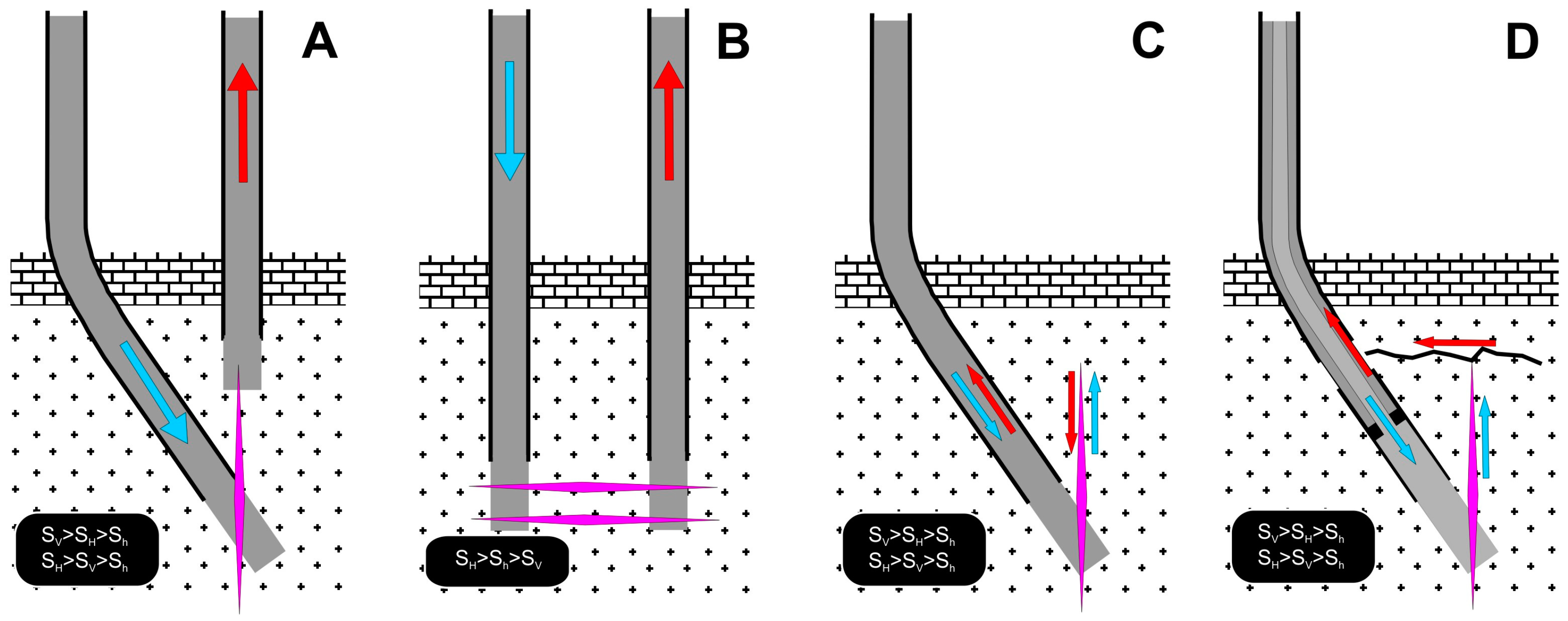
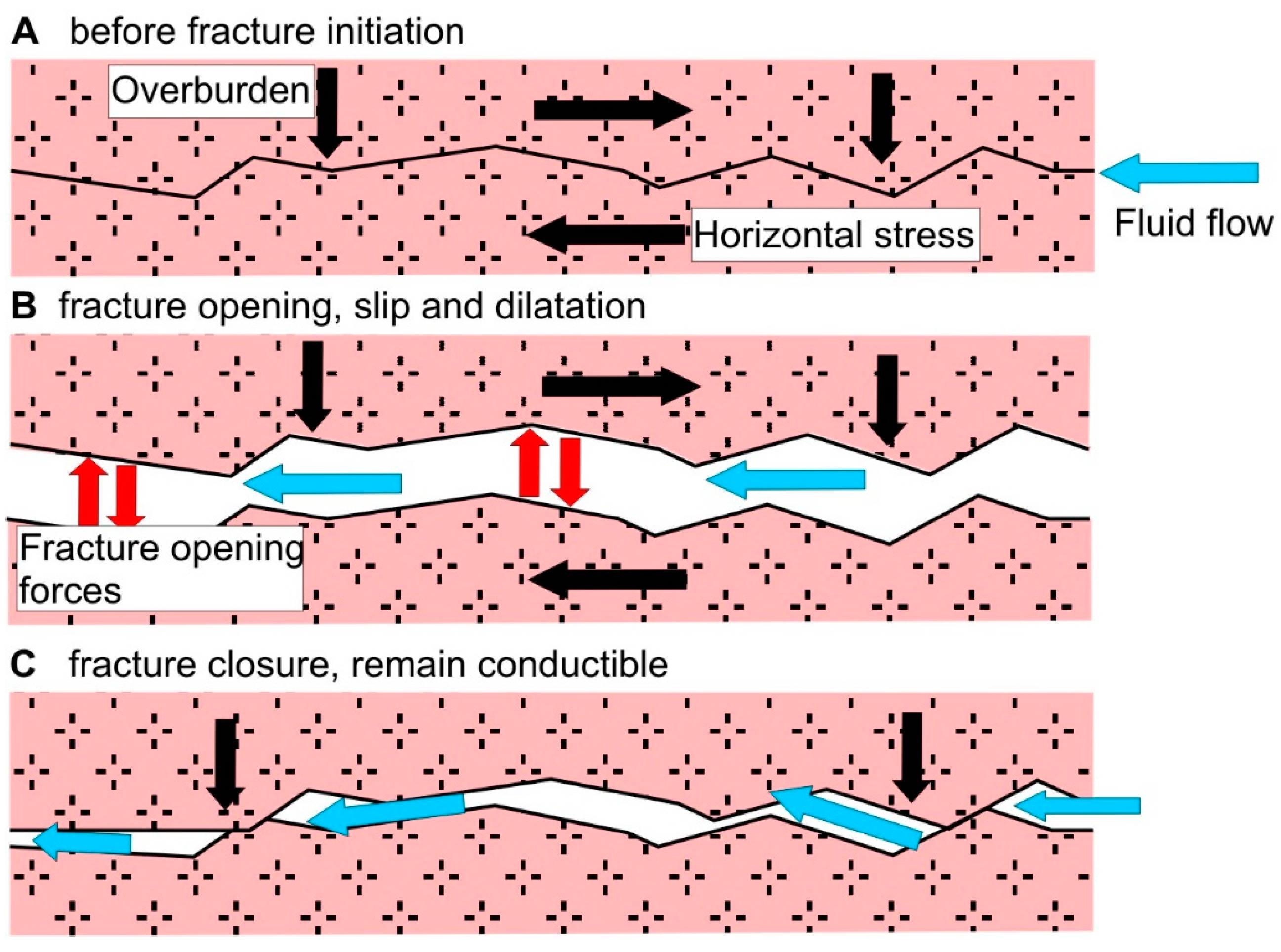
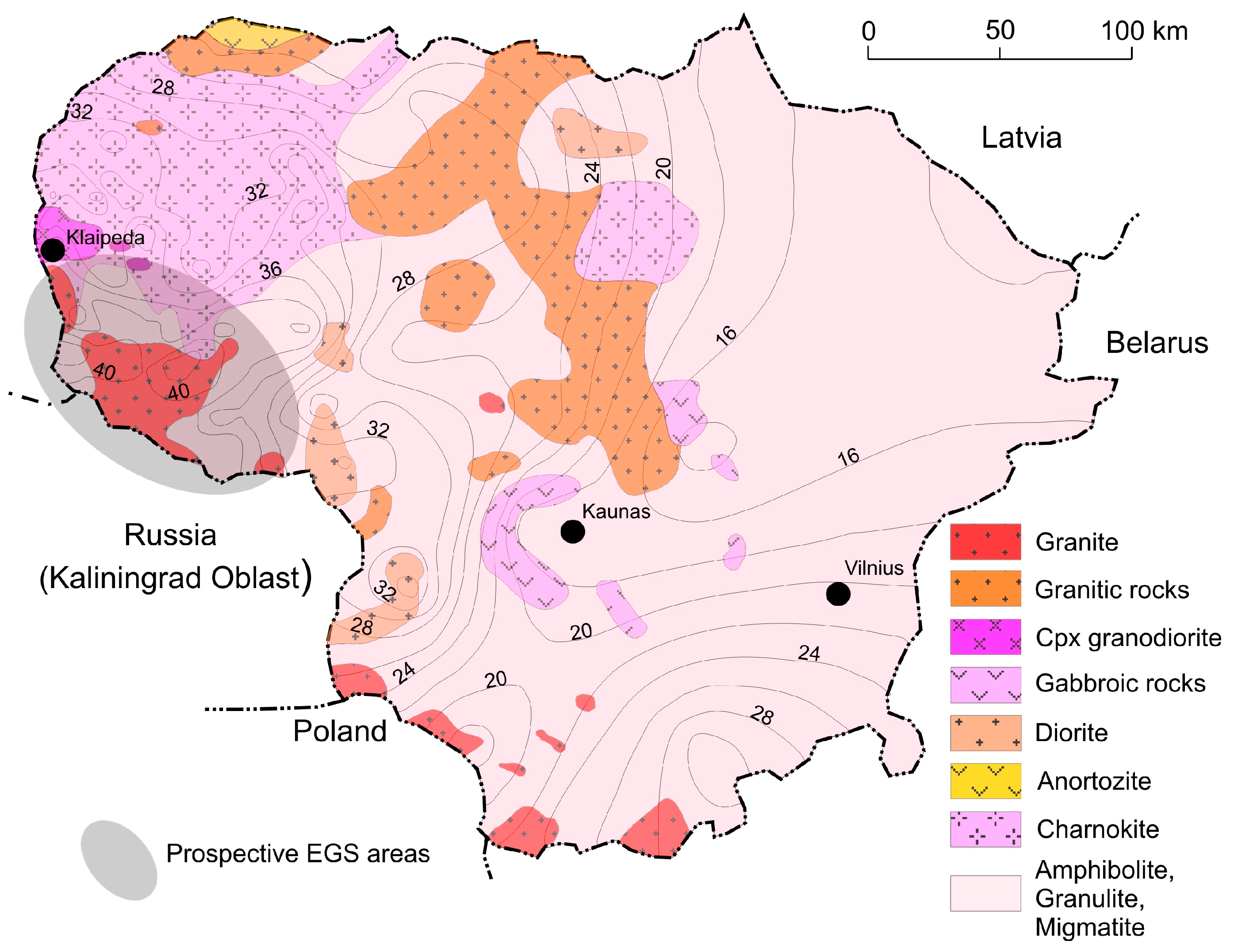

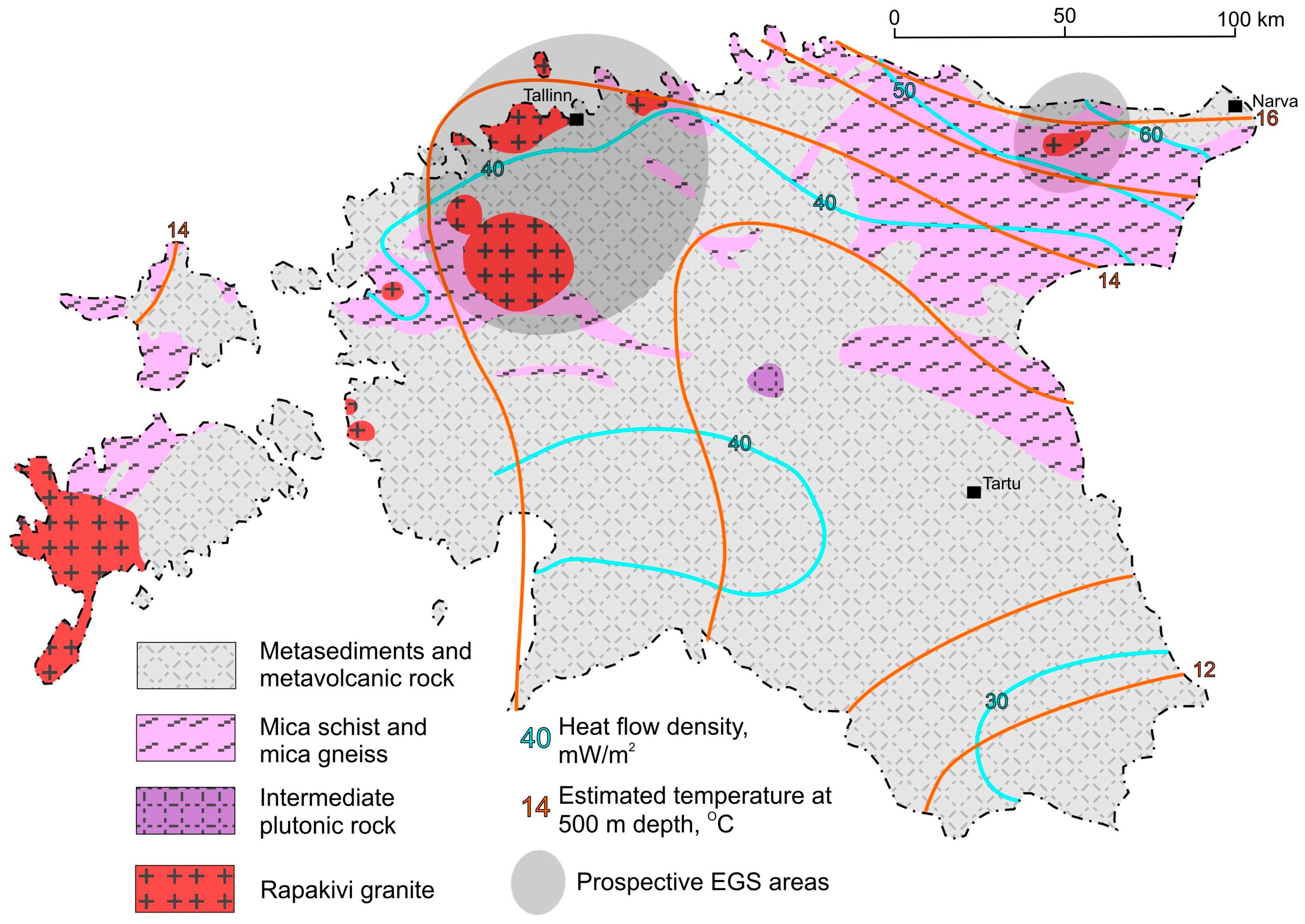

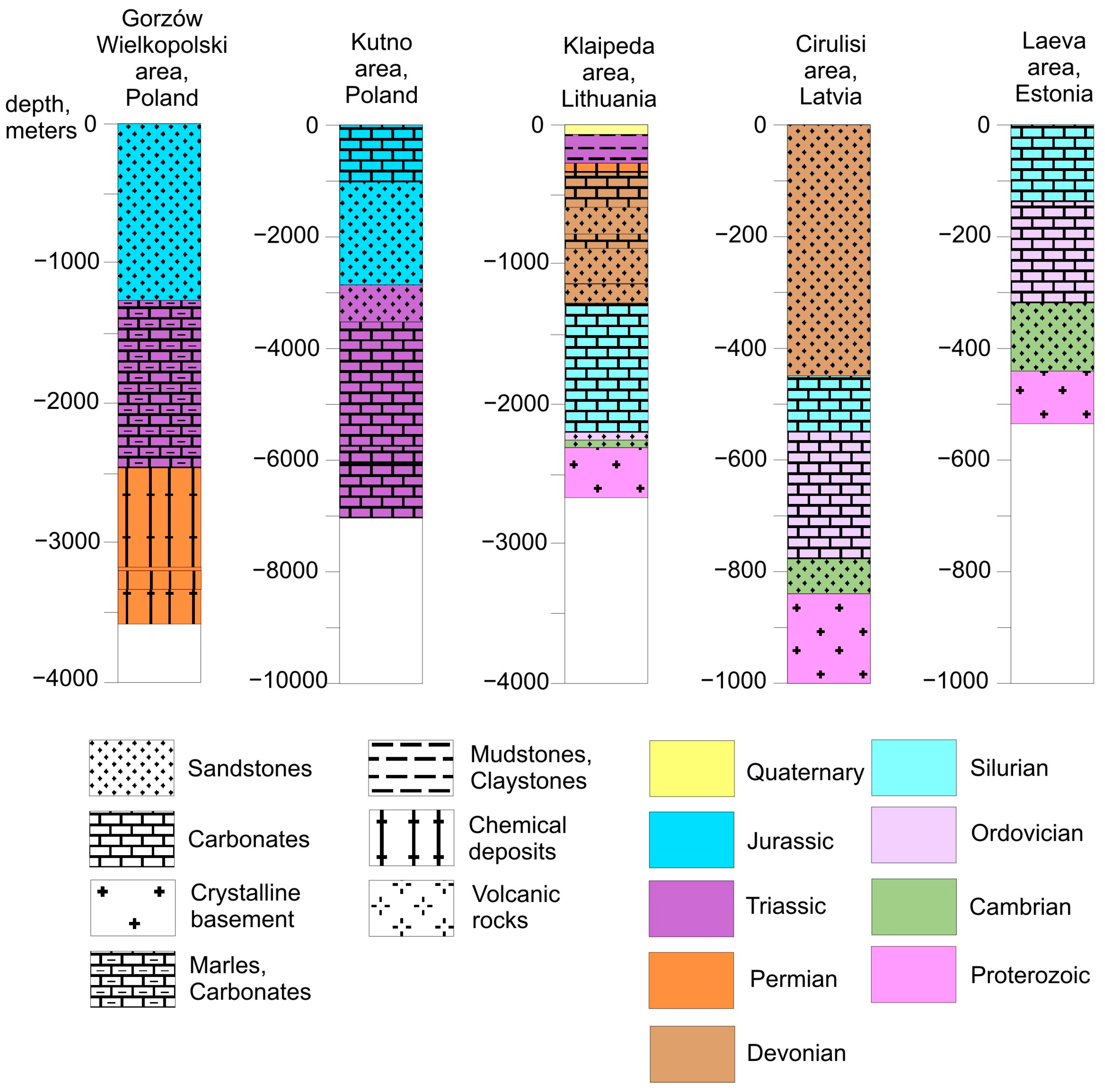
| Country (EGS Site), Activities, Duration | Depth, m | Temperature, °C (Geothermal Gradient, °C/km) | Geological Conditions | Target Zone Stimulation Mechanism | References |
|---|---|---|---|---|---|
| United Kingdom (Rosemanowes) 1977–1985 | about 2000 | below 100 | Granite Carnmenellis batolith, Permian. Strike-slip tectonic regime | hydraulic, hydroshearing | [4] |
| France (Soultz-sous-Forêts) 1990-present | 5200 | about 200 (about 38) | Porphyric granites MFK, two-mica granites, Carboniferous, Normal with strike-slip component tectonic regime | hydraulic, hydroshearing | [20,27,28] |
| Germany (Groß Schönebeck) 2006-present | about 4100 | 149 (about 36) | Clastic and volcanic rocks (rhyolite, andeside) Rotliegend, Permian. Normal-strike-slip tectonic regime | hydraulic | [29,30,31] |
| Germany (Landau) 2005-present | 2200 | about 160 (about 72) | Porphyric granites MFK, two-mica granites, Carboniferous, Normal with strike-slip component tectonic regime | hydraulic, hydroshearing | [27,28,32] |
| Finland (ST1 Espoo) 2014-present | 6400 | 100–110 (15–17) | Low porosity, natural fractured granite, pegmatite, gneiss and amphibolite. Precambrian Reverse faulting regime. | hydraulic | [21,33] |
| Potential EGS Site | Geothermal Gradient, °C/1000 m | Heat Flow Anomaly, mW/m2 | Target Depth, m, Temperature, °C | Lithology, Stratigraphy | References | |
|---|---|---|---|---|---|---|
| Lithuania | Zemaiciu Naumiestis intrusion (ZNI), south of Klaipeda | 35–40 | 83–100 | 4500–5000, 150 | syenogranite, porphyric quartz monzodiorite | [41,65] |
| Latvia | Precambrian batholith, south of Liepalia | up to 35 | No data | below 1740, 140 at 4000 * | intrusive igneous rocks | [44,66] |
| Precambrian batolith, center and south of the country | up to 35 | No data | below 1500, 140 at 4000 * | intrusive igneous rocks | [44] | |
| Estonia | Nothern and center of the country, Precambrian basement | 26–28 in sedimentary cover; 14 in the Precambrian | 40–50 42 | 4000, 58–73 ** depending on the site | rapakivi granites | [49,67,68] |
| Poland | Karkonosze Mountains, SW of the country | 44 | 65 | 4000, 165 | intrusive igneous rocks, Carboniferous | [31,61] |
| Gorzów Block NW of the country | 35–40 | 105 | 4300, 160 | trachyandesites, Permian | [31,61] | |
| Mogilno-Łódź Trough country center | up to 34 in the best target area | 75–90 | 5000–6500, 165–195 | sandstones, buntsandstein, lower Triassic | [31,61,63] | |
| Szczecin Trough NW of the country | up to 27 | 85–100 | >5000, above 150 | sediments, Carboniferous, Permian | [61,63,69] | |
| Upper Silesian Block S of the country | up to 45 | 80–95 | >5000, 170 | clastic deposits of Carboniferous | [61,63,70] | |
Disclaimer/Publisher’s Note: The statements, opinions and data contained in all publications are solely those of the individual author(s) and contributor(s) and not of MDPI and/or the editor(s). MDPI and/or the editor(s) disclaim responsibility for any injury to people or property resulting from any ideas, methods, instructions or products referred to in the content. |
© 2023 by the authors. Licensee MDPI, Basel, Switzerland. This article is an open access article distributed under the terms and conditions of the Creative Commons Attribution (CC BY) license (https://creativecommons.org/licenses/by/4.0/).
Share and Cite
Moska, R.; Labus, K.; Kasza, P.; Moska, A. Geothermal Potential of Hot Dry Rock in South-East Baltic Basin Countries—A Review. Energies 2023, 16, 1662. https://doi.org/10.3390/en16041662
Moska R, Labus K, Kasza P, Moska A. Geothermal Potential of Hot Dry Rock in South-East Baltic Basin Countries—A Review. Energies. 2023; 16(4):1662. https://doi.org/10.3390/en16041662
Chicago/Turabian StyleMoska, Rafał, Krzysztof Labus, Piotr Kasza, and Agnieszka Moska. 2023. "Geothermal Potential of Hot Dry Rock in South-East Baltic Basin Countries—A Review" Energies 16, no. 4: 1662. https://doi.org/10.3390/en16041662






